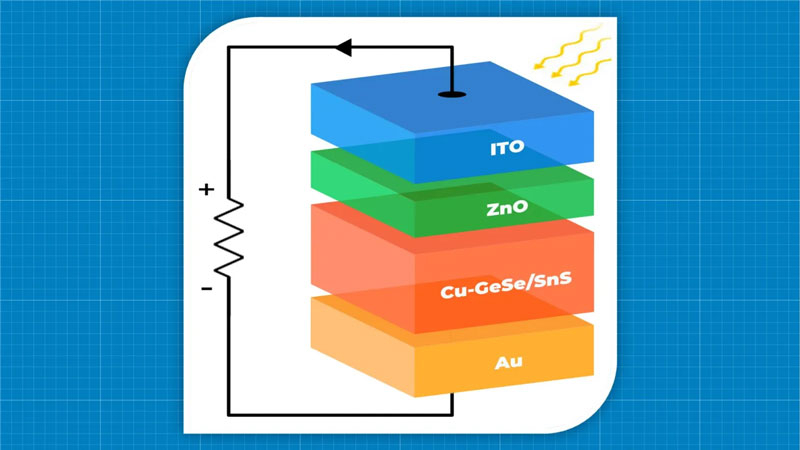World News11.04.2024
New quantum material boosts solar cell efficiency to 190%

QAZAQ GREEN. Researchers from Lehigh University have developed a material with the potential to increase the efficiency of solar panels drastically. But what makes it different?
Constant innovations improving efficiency have become crucial, especially in meeting global energy needs, according to Interesting Engineering.
Quantum material to the rescue
The research team debuted a prototype using a quantum material as the active layer in a solar cell. That material showed a photovoltaic absorption of 80% and external quantum efficiency of up to 190%. This feat is remarkable because it exceeds the theoretical limit set by the Shockley-Queisser efficiency for traditional silicon-based solar cells. In comparison, conventional solar cells have a maximum EQE of 100%.
“This work represents a significant leap forward in our understanding and development of sustainable energy solutions. Highlighting innovative approaches that could redefine solar energy efficiency and accessibility in the near future,” said Chinedu Ekuma, a professor of physics at Lehigh University and author of the research paper, in a statement.
The material’s remarkable efficiency improvement boils down to a unique feature called “intermediate band states.” These intermediate band states refer to specific energy levels within the material’s electronic structure, positioned to be ideal for converting light to energy.
In this new material, the intermediate band states enable the capture of photon energy lost by traditional solar cells. Despite EQE figures of up to 100%, traditional cells lose photon energy through reflection and heat.
The team leveraged “van der Waals gaps,” atomically small gaps between layered two-dimensional materials. They inserted atoms of zerovalent copper between layers of a two-dimensional material made of germanium selenide and tin sulfide.
Consider two thin (two-dimensional) sheets of material with tiny gaps called van der Waals gaps. To make them more efficient, the researchers inserted atoms of a zerovalent copper into these gaps, boosting the cell’s efficiency.
An advanced prototype
After extensive computer modeling of the system, Ekuma developed the prototype.
“Its rapid response and enhanced efficiency strongly indicate the potential of Cu-intercalated GeSe/SnS as a quantum material for use in advanced photovoltaic applications, offering an avenue for efficiency improvements in solar energy conversion,” he said. According to Ekuma, it is a promising candidate to develop next-generation and high-efficiency solar cells.
Incorporating this new material into existing solar energy systems will require additional research and development efforts. However, Ekuma highlighted that the experimental technique used to create these materials is already highly advanced. Over time, scientists have perfected a method that inserts atoms, ions, and molecules into materials with precision.
According to the International Energy Agency, in 2023, solar PV alone accounted for three-quarters of renewable capacity additions worldwide. In 2022, solar PV generation increased by up to 26%, reaching almost 1,300 TWh. That showed the largest absolute generation growth of all renewable technologies in 2022, surpassing wind for the first time in history.
Ekuma’s research was funded in part by a grant from the U.S. Department of Energy.
Details of the research are published in the journal Science Advances.
EU fossil generation below 25% for the first month ever
Progress on world’s first artificial energy island revealed
Scientists make electricity from air moisture using bacterial nanowires
EU keen to deepen renewable energy cooperation with Kazakhstan - ambassador
Drilling into magma: Risky plan takes geothermal to supercritical extremes
Record renewables propel the world towards a new era of falling fossil generation
Advanced 'high-density waterless hydro' energy plant gets green light
Eurostar aims to have all their trains powered by renewable energy by 2030
‘World’s first’ wooden wind turbine blades installed in Germany
Natron to kick off mass-production of long-life sodium-ion batteries
Tajikistan intends to fully switch to renewable energy sources by 2032 - deputy PM
Floating solar can power Africa’s energy goals, study finds
South Korean сompanies to modernize Kazakhstan's power plants, and GRES Topar
Decarbonization and sustainable development to take center stage at the 11th Annual Downstream Central Asia & Caspian Conference
Renewable electricity share in Turkey nears 50%
Sinn Power plans groundbreaking floating photovoltaic system in Bavaria
Swiss researchers boost efficiency of vertical axis wind turbines
Rapid expansion of batteries will be crucial to meet climate and energy security goals set at COP28
Georgia acquires first floating solar power plant
Wind turbine blades get a sustainable upgrade












